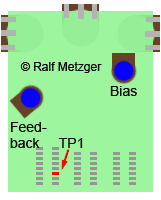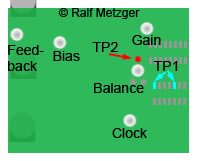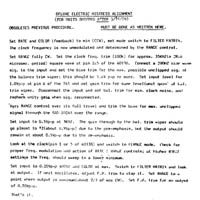| Ralf Metzger | Home | Palm-Software | DIY Hifi | Modellbau | Urlaubsbilder |
| Stompboxes | Home -> Stompboxes -> Mistress |
| Aglignment | ||
Back to the main pageContent:
PrefaceI strongly recommend that you adjust your Electric Mistress only if you have sufficient knowledge in electronics. You can easily damage the BBD which is no more available as spare part which means your Mistress is irreparable damaged. Tools required:The two trimpot versions can be adjusted by ear and a frequency generator; all other versions require an oscilloscope. A frequency counter helps, but is not essential. ESD protection is mandatory. 2 Trimpots (V1, V2, V3, V4, V5)Trimpot location. Shown is the copper side of the PCB as you will see it when you open the case and the PCB is still in place. For adjustment the PCB doesn't need to be removed.
1. Bias adjustment Set the RATE and COLOR controls to minimum (CCW) and mode switch to to the FILTER MATRIX position (no sweep). Set RANGE to maximum (CW). Connect a 200 Hz sine wave to the input and adjust the BIAS trim for maximum input signal amplitude without clipping at SAD1024 pin 6 or 12 (TP1*). The input amplitude should now be greater than 1 V p-p. *) To avoid short circuiting the BBD by the probe I reccoment using the big solder points along the circuit path from pin 6 and 12. 2. Feedback adjustment Set the RATE to mid position and the COLOR and RANGE to maximum (CW). Set the mode switch to FLANGE position. Remove the input. Listen to the output or observe on scope. Adjust FEEDBACK trim right before oscillation starts. If the level of noise (a droning sound) at certain sweep positions is unacceptable reduce feedback a little more. 3 Trimpots (V6)Trimpot location. Shown is the copper side of the PCB as you will see it when you open the case and the PCB is still in place. For adjustment the PCB doesn't need to be removed.
1. Clock adjustment Set the RATE and COLOR controls to minimum (CCW) and mode switch to the FILTER MATRIX position (no sweep). Set the RANGE to maximum (CW). The VCO input voltage at pin 2 of LM311 is now at its highest peak. Set the CLOCK trim for approximately 35 kHz (a 28.6 ms period) square wave at pin 1 or 5 of the 4013 (TP1). 2. Bias adjustment Keep the RATE and COLOR controls at minimum (CCW), RANGE at maximum (CW) and mode switch at FILTER MATRIX position (no sweep). Connect a 200 Hz sine wave to the input and adjust the BIAS trim for maximum input signal amplitude without clipping at SAD1024 pin 6 or 12 (TP2*). The input amplitude should now be greater than 1 V p-p. *) To avoid short circuiting the BBD by the probe I reccoment using the big solder points the circuit path from pin 6 and 12 leads to instead. 3. Feedback adjustment Set the RATE to mid position and the COLOR and RANGE to maximum (CW). Set the mode switch to FLANGE position. Remove the input. Listen to the output or observe on scope. Adjust FEEDBACK trim right before oscillation starts. If the level of noise (a droning sound) at certain sweep positions is unacceptable reduce feedback a little more. 5 Trimpots (Deluxe V1, V2, V3)Trimpot location. Shown is the copper side of the PCB as you will see it when you open the case and the PCB is still in place. For adjustment the PCB doesn't need to be removed.
1. Clock adjustment Set the RATE and COLOR controls to minimum (CCW) and mode switch to the FILTER MATRIX position (no sweep). Set the RANGE to maximum (CW). The VCO input voltage at pin 2 of LM311 is now at its highest peak. Set the CLOCK trim for approximately 35 kHz (a 28.6 ms period) square wave at pin 1 or 5 of the 4013 (TP1). 2. Bias adjustment Keep the RATE and COLOR controls at minimum (CCW), RANGE at maximum (CW) and mode switch at FILTER MATRIX position (no sweep). Connect a 200 Hz sine wave to the input and adjust the BIAS trim for maximum input signal amplitude without clipping at the wiper of BALCANCE trim (TP2). The input amplitude should now be greater than 1.6 V p-p. 3. Gain and Balance adjustment Keep the RATE and COLOR controls at minimum (CCW), RANGE at maximum (CW) and mode switch at FILTER MATRIX position (no sweep). Connect a 200 Hz sine wave to the input and adjust its level to achieve an amplitude of 1.0 V p-p at pin 6 of the 741 (TP3). Set the GAIN trim to 1.0 V p-p at the wiper of BALCANCE trim (TP2). Disconnect the input and set the BALANCE trim for minimum clock noise. Repeat gain and balance adjustment procedure until no more changes are necessary. 4. Bias adjustment (2) Repeat bias adjustment at various settings of RANGE. 5. Feedback adjustment Set input to 0.2 V p-p 400 Hz and set the COLOR to maximum (CW). Switch to FILTER MATRIX position (no sweep) and check the output. If unit oscillates, adjust FEEDBACK trim to stop it. Set the RANGE to a point where output is maximum (about 2/3 of way CW). Set FEEDBACK trim for an output of 0.70 V p-p. 6. Final checks Set input to 0.5 V p-p at 3 kHZ. The gain through the wiper of BALANCE trim (TP2) should go almost to x2 (about 0.9 V p-p) due to pre-emphasis, but the output should remain at about 0.5 V p-p due to re-emphasis. Here is the orignal align instruction by Electro-Hamonix (shown with permission by Mike Matthews of New Sensor Corp./Electro-Harmonix): 4 Trimpots (Deluxe Reissue V4, V5)Trimpot location. Shown is the copper side of the PCB as you will see it when you open the case and the PCB is still in place. For adjustment the PCB doesn't need to be removed.
1. Clock adjustment Set the RATE and COLOR controls to minimum (CCW) and mode switch to the FILTER MATRIX position (no sweep). Set the RANGE to maximum (CW). The VCO input voltage at pin 2 of LM311 is now at its highest peak. Set the CLOCK trim for approximately 40 kHz (a 25 us period) square wave at pin 1 or 5 of the 4013 (TP1). 2. Bias adjustment Keep the RATE and COLOR controls at minimum (CCW), RANGE at maximum (CW) and mode switch at FILTER MATRIX position (no sweep). Connect a 200 Hz sine wave to the input and adjust the BIAS trim for maximum input signal amplitude without clipping at pin 4 of the RD5106A (TP2). The input amplitude should now be greater than 1.6 V p-p. 3. Mix adjustment Keep the RATE and COLOR controls at minimum (CCW), RANGE at maximum (CW) and mode switch at FILTER MATRIX position (no sweep). The original schematic only says "4 kHZ NULL at output". I interpret this: Connect a 4 kHz sine wave to the input and adjust the MIX trim for no signal at the output. (I had been reported that using a 400 Hz signal gives better results. If you are not satisfied by aligning to a 4 kHz signal, try 400 Hz.) 4. Feedback adjustment Set input to 0.2 V p-p 400 Hz and set the COLOR to maximum (CW). Switch to FILTER MATRIX position (no sweep) and check the output. If unit oscillates, adjust FEEDBACK trim to stop it. Set the RANGE to a point where output is maximum (about 2/3 of way CW). Set FEEDBACK trim for an output of 0.70 V p-p. |






